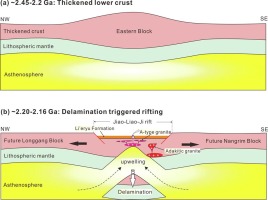当前位置:
X-MOL 学术
›
Precambrian. Res.
›
论文详情
Our official English website, www.x-mol.net, welcomes your feedback! (Note: you will need to create a separate account there.)
Synchronous A-type and adakitic granitic magmatism at ca. 2.2 Ga in the Jiao–Liao–Ji belt, North China Craton: Implications for rifting triggered by lithospheric delamination
Precambrian Research ( IF 3.2 ) Pub Date : 2020-06-01 , DOI: 10.1016/j.precamres.2020.105629 Jin Liu , Jian Zhang , Changqing Yin , Changquan Cheng , Xiaoguang Liu , Chen Zhao , Ying Chen , Xiao Wang
Precambrian Research ( IF 3.2 ) Pub Date : 2020-06-01 , DOI: 10.1016/j.precamres.2020.105629 Jin Liu , Jian Zhang , Changqing Yin , Changquan Cheng , Xiaoguang Liu , Chen Zhao , Ying Chen , Xiao Wang

|
Abstract The Jiao–Liao–Ji belt (JLJB) underwent back-arc or intra-continental rifting during the early Palaeoproterozoic but the underlying mechanism remains unclear. To address this issue, this study focuses on the petrogenesis of widespread Palaeoproterozoic granitoids on Liaodong Peninsula, China. Zircon U–Pb dating and geochemical and Hf isotopic data suggest that these granitoids were formed at ca. 2.2 Ga and they can be divided into A-type and adakitic granites. The A-type granites have relatively high SiO2, K2O, Zr, Ga, Nb and Y contents, and low CaO, MgO, Al2O3 and Sr contents. Based on these characteristics, eHf(t) values (−0.8 to +2.8) and TDM2 ages (2797–2569 Ma), the A-type granites are inferred to be derived from Neoarchaean tonalite–trondhjemite–granodiorites in a rift setting. In contrast, the coeval adakitic granites have relatively high Na2O, Al2O3 and Sr contents and high Sr/Y and LaN/YbN ratios, but low MgO, Ni, Yb and Y contents, suggesting a magma source with garnet but no plagioclase in the residue beneath thickened lower crust. Their variable eHf(t) values (−8.5 to +6.9) and TDM2 ages (3276–2305 Ma) indicate that the adakitic magmas were mainly generated by the partial melting of Meso–Neoarchaean crust. The co-existence of contemporaneous ca. 2.2 Ga adakitic and A-type granites provides evidence that the JLJB underwent regional rifting in the Palaeoproterozoic, most likely due to delamination of a thickened lithosphere, as follows. (1) In the Neoarchaean, the lower crust of the Longgang Block underwent granulite- and/or eclogite-facies metamorphism due to continuous thickening, which resulted in increasing lower crustal density. (2) The thickened lower crust became unstable and delaminated at ca. 2.2 Ga. Asthenospheric upwelling following this lithospheric delamination triggered the thinning of the overlying lithosphere. The upper crust and remnant thickened lower crust were partially melted to form the A-type and adakitic granites, respectively. The rifting likely resulted in the separation of the Longgang and Nangrim blocks, prior to their amalgamation in the late Palaeoproterozoic to form the JLJB.
更新日期:2020-06-01
















































 京公网安备 11010802027423号
京公网安备 11010802027423号